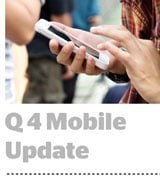 Combined year-end results from four ad tech companies show that rich media, location-based targeting and increasing brand spend drove expansion in the mobile real-time bidding (RTB) space for the previous quarter.
Combined year-end results from four ad tech companies show that rich media, location-based targeting and increasing brand spend drove expansion in the mobile real-time bidding (RTB) space for the previous quarter.
Global bid responses for both mobile Web and app inventory continue to grow, according to mobile RTB ad exchange Smaato. Based on activity across Smaato’s ad exchange, SMX, global bid responses for mobile Web and app inventory increased 209% and 64%, respectively, between Q3 and Q4.
Global advertising spend on rich media also increased by 117% between the third and fourth quarter. In contrast, image ad type (banner ads) saw a 15% drop.
“Even though banner ads still dominate, the trend is increasingly moving toward rich media, particularly video,” said Smaato’s chief strategy officer, Ajitpal Pannu. “And mobile Web inventory is strong, but the demand for app inventory is catching up.”
Additionally, location and device IDs generated higher eCPMs (effective cost per mille, or ad revenue for every thousand impressions) for publishers. Compared to inventory that did not include device ID or location parameters, eCPMs increased by 58% when the inventory included device IDs and it rose 264% when it included location data.
Despite the benefits, marketers are slow to leverage location data in their campaigns, Pannu said.
“The challenge is that only about 20% of the inventory that comes from mobile devices actually contains location data,” he said. “This is partially because people are not educated on the value of passing and capturing that data and monetizing it. I think 2014 will see more self-serve products that make it easier to work with location data … so that you will essentially be able to allocate a budget based on location.”
Mobile demand-side platform (DSP) provider AdFonic looked at the breakdown between Android and iOS campaigns in its latest Global AdMetrics Report. In Q4 2013, Android campaigns accounted for 46% of all impressions bought through Adfonic’s mobile DSP, Madison, up from 32% in the third quarter.
Meanwhile, iOS took a 48% impressions share, down from 63% in Q3, leaving Android and iOS “virtually neck-and-neck,” noted the report’s author, Adfonic CEO and co-founder Victor Malachard.
Of all mobile devices, iPhone and iPad deliver the first and second-most ad impressions, respectively. However, Samsung’s Galaxy S3 replaced Apple’s iPod Touch in third place, increasing its share of impressions from 3% in Q3 to 5.1% in Q4, while the iPod Touch dropped from 6% in Q3 to 4.3% in Q4.
JiWire, a location data analytics provider, reported similar findings. Based on a survey of approximately 2,200 mobile users conducted between November and December and data points from its mobile ad platform, the iPhone and iPad held the top two spots in terms of ad request percentages at 35.1% and 28.6%, respectively.
AdExchanger Daily
Get our editors’ roundup delivered to your inbox every weekday.
Daily Roundup
The Samsung Galaxy S3 took third place, at 8.1% of total ad requests. Additionally, 68% of mobile ads that respondents saw included rich media ad formats, whereas only 32% consisted of banner ads.
In its Q4 report, mobile ad exchange Nexage saw marketers delving deeper into location-based ad campaigns. Local campaign spend based on ZIP codes or cities increased 433% during the 2013 holiday season (Black Friday to Christmas) compared to the rest of the year. The number of hyperlocal campaigns targeting consumers based on lat/long data from their mobile devices grew 142%.
Nexage also reported a sharp increase in brand spend, with a 153% increase between October and December last year. “The accelerated holiday brand spend is not a blip or an exception; it is a kick-start to a significant shift in ad spend, especially between mobile and online,” insisted Nexage CMO Victor Milligan. “Specifically, forecasts predict that mobile spend will overtake online ad spend by 2017.”













